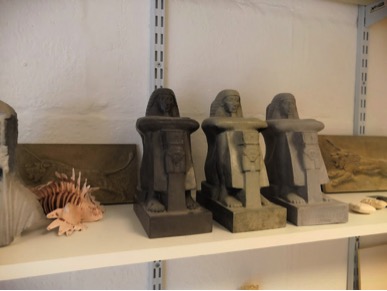
On Friday 15th March, the CEEF team visited the ThinkSee3D studio in Eynsham, a small village outside Oxford. The purpose of the visit was to gain firsthand insights into the processes of 3D printing, photogrammetry and digital 3D modeling with founder-owner, Steve Dey, and find out more about the perks and challenges of working as a small-scale heritage business.

The visit commenced with a tour of the studio followed by an informal Q&A session with Steve about various aspects of our projects, and the nature of 3D more generally. We also had the opportunity to handle and interrogate a range of 3D printed objects made in varying materials, including a silicone heart made for the Science Museum in London (this was one of my personal favourites!), a giant resin Ichthyosaur dinosaur bone and the Roman portrait bust of the young Greek Antinous made from resin for the British Museum shop. You can read more about the original bust here.

ThinkSee3D’s client base largely comprises universities and museums – both for research and exhibition purposes (for example, photogrammetry, 3D printing from CT scan data and original objects, and digital 3D modeling), as well as commercial (namely, producing high quality 3D prints of objects in museums for retailing). In terms of the latter, this area appears to be pushing the company in new directions, especially with the different types of materials they are experimenting with. For example, the aforementioned resin bust of Antinous will soon be cold cast in bronze (this would indeed make a very grand statement on somebody’s mantelpiece!). They’re also in the process of trialing pewter – a low cost metal alloy that is said to offer significantly better detail than, for example, resins. In the event that something goes wrong, you can also quite easily melt it down and start again!

As a museum curator and Egyptologist, something that I have been thinking about a lot since our visit to ThinkSee3D, is the notion of authenticity and also the value of 3D printing an object, as opposed to making one via more ‘traditional’ means. For example, in my project working on the construction and decoration of ancient Egyptian coffins (see here for more details), we have been collaborating with Dr Geoffrey Killen, an expert in ancient woodworking techniques, who has been making sections of replica coffins, and complete coffins, for us from modern woods. Thus, when it comes to explaining to diverse audiences the way a coffin is made using a hands-on activity (specifically a coffin/coffin section which can be assembled and dis-assembled as part of our Egyptian coffins ‘Pop-Up’ experience in Wisbech – you can read more about this here), – which is better? A 3D printed coffin? Or a wooden replica coffin made by hand?
A 3D printed coffin allows you to show the original grain in the wood, its imperfections and the warping shape of the planks. But, the 3D printed material isn’t going to look or feel anything like wood (the closest texture you’d be able to achieve is most probably gypsum or resin). It’s also more expensive, especially if 3D printing on a 1:1 scale. A wooden replica, on the other hand, is obviously more authentic in terms of material, but it would be made from newly sawn wood, so lacks any of the original ancient features. There’s also a concern with the fragility and durability of the different materials, particularly when the coffin would be handled on a regular basis (at least 12 hours per week over 3 months). Gypsum, for example, takes time to produce, has a chemical bonding agent and can break if easily dropped. Resin casts are faster to produce, but can be flawed (bubbling) and are very heavy, while wood (depending on what species you use) can splinter, but if something does happen to it, it is much more affordable to make another one. For something like this, therefore, I believe that turning to photogrammetry and 3D digital modeling, complemented by a wooden replica, is the ideal way to go.

And, this is precisely the point of this Fellowship – to find the most effective ways of collaborating with an industry partner in order to advance our research and skillsets, while also providing new strands of end user products for ThinkSee3D and Museum in a Box.
We’re also learning from each other’s experiences. Cat, my other colleague working with ThinkSee3D, for example, is developing a set of guidelines for best practice methods for using digital and replica objects in museum and heritage settings (you can read more here). My project is well-aligned to her research, and to help feed into it, I have also developed a feedback form for visitors engaging with our ‘Pop-Up’ museum in Wisbech to see how their experience of learning about the industry of making ancient Egyptian coffins is augmented, or not, through handling a replica wooden coffin alongside seeing digital 3D models, as well as original objects in the flesh. Do people have a preference? Are they significantly aware of the differences? I look forward to sharing some of these results with you over the coming months.